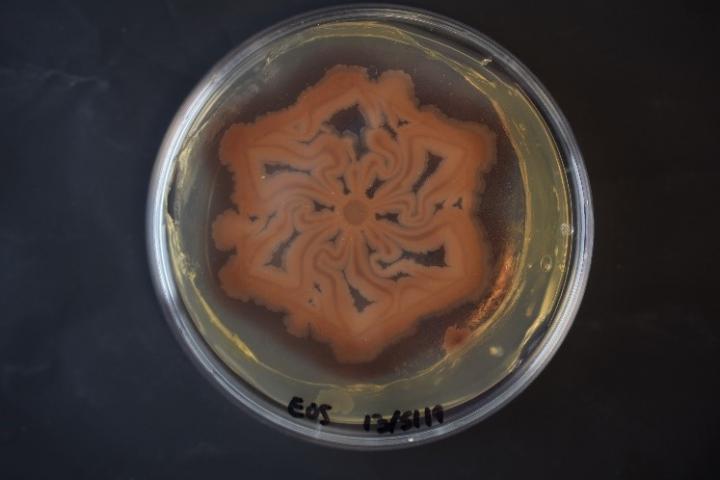New technique for engineering living materials and patterns

A bacterial biofilm patterned using MeniFluidics. Credit: University of Warwick Usage Restrictions: Only to be used in conjunction with this story
· While various techniques such as 3D printers have been utilized for developing ELMs, these techniques are typically limited for static patterns and suffer for technical complications
· Researchers at the Departments of Physics and the School of Life Sciences, University of Warwick used fluidic channels to make patterns using bacterial cells
· The method, named MeniFluidics, opens the door for further innovations and creation of arts, from ELMs, fundamental research into cellular interactions, to bio-art and tissue engineering
A new method for engineering living materials called 'MeniFluidics', made by researchers at the University of Warwick could see a transformation in tissue engineering and bio-art, as well as new ways to research cellular interactions.A bacterial biofilm patterned using MeniFluidics.
Living cells have many properties that non-living materials simply don't. The ability of controlling the emergent behaviours of cells and organising them into arbitrary patterns is a key step forward towards utilizing living materials, for uses such as organs on a chip. This is why new technologies are being developed to obtain such an ability.
Physicists and biologists at the University of Warwick have teamed up to develop a new method for controlling cellular patterns, published in the journal ACS Synthetic Biology, titled 'Pattern engineering of living bacterial colonies using meniscus-driven fluidic channels', their new technique is called MeniFluidics.
Grounded on the physics of meniscus generation, the researchers implemented structures into gel surfaces. Evaporation of water from gel materials lead to formation of open channels which can be used for guiding the direction and speed of cellular expansion.
Dr Vasily Kantsler, from Department of Physics at the University of Warwick comments;
“I believe that our catchy named (Menifluidics) technique will enable new opportunities in biophysical and biomedical research and applications such as antibiotic resistance and biofouling”
Dr Munehiro Asally, from School of Life Science at the University of Warwick adds;
“We hope MeniFluidics will be used widely by biophysics, microbiologists, engineers and also artists! As it is a simple and versatile method.”
###
NOTES TO EDITORS
High-res images available credit to the University of Warwick at: https:/
Paper available to view at: https:/
For further information please contact:
Alice Scott
Media Relations Manager – Science
University of Warwick
Tel: +44 (0) 7920 531 221
E-mail: alice.j.scott@warwick.ac.uk
Media Contact
All latest news from the category: Life Sciences and Chemistry
Articles and reports from the Life Sciences and chemistry area deal with applied and basic research into modern biology, chemistry and human medicine.
Valuable information can be found on a range of life sciences fields including bacteriology, biochemistry, bionics, bioinformatics, biophysics, biotechnology, genetics, geobotany, human biology, marine biology, microbiology, molecular biology, cellular biology, zoology, bioinorganic chemistry, microchemistry and environmental chemistry.
Newest articles

Superradiant atoms could push the boundaries of how precisely time can be measured
Superradiant atoms can help us measure time more precisely than ever. In a new study, researchers from the University of Copenhagen present a new method for measuring the time interval,…

Ion thermoelectric conversion devices for near room temperature
The electrode sheet of the thermoelectric device consists of ionic hydrogel, which is sandwiched between the electrodes to form, and the Prussian blue on the electrode undergoes a redox reaction…

Zap Energy achieves 37-million-degree temperatures in a compact device
New publication reports record electron temperatures for a small-scale, sheared-flow-stabilized Z-pinch fusion device. In the nine decades since humans first produced fusion reactions, only a few fusion technologies have demonstrated…





















